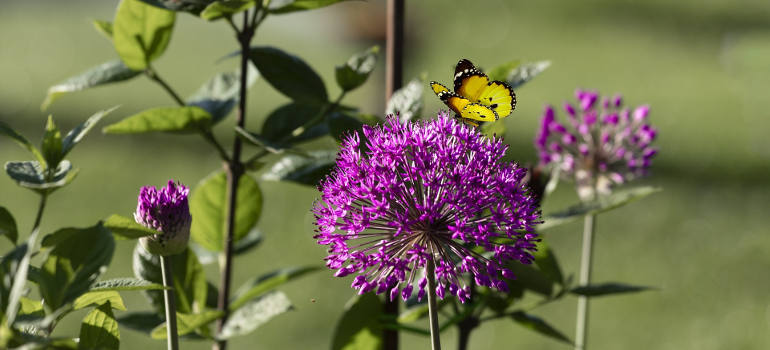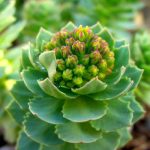
A butterfly garden (or butterfly habitat) is a place dedicated for butterflies to feed and hydrate. It also helps butterflies find shelter, as many of their natural habitats are being lost due to human activities and urbanisation.
Certain plants are very good at attracting butterflies and moths, which helps with pollination. A well-made butterfly garden will easily attract these lovely creatures at every stage of their life cycle (egg, larva, pupa, and adult). Butterflies are most active during the height of the plant growth in spring and late summer.
Table of Contents
Tips for growing your own butterfly garden
- Do your research first. Before you create your butterfly garden, you must learn more about what kinds of butterflies are native to your area. Knowing which butterflies you’re trying to attract is essential in selecting the nectar and host plants for your butterfly garden. In addition to consulting a guide on butterfly species and distribution, you should also take some extra time to observe and research which butterflies are common in your area.
- Plan the garden. Planning your butterfly garden is important to both you and the butterflies. On one hand, planting in groups lets butterflies find flowers and plants more efficiently, and on the other – proper landscaping will allow you to observe butterfly activities more closely. A suitable layout should consider the size which mature plants reach and grouping them by bloom time and colour. Place taller plants at the back of the garden, or plant a butterfly bush and start adding smaller plants in the front. You should also think about the garden location so you can view it from your window or patio.
- Plant in a sunny location. Both the butterflies and the plants which attract them need a lot of sunlight – at least 6 hours every day. Nectar-producing flowers should be placed where they receive sunshine from mid-morning to mid-afternoon. Butterflies require warmth to fly and they usually feed only in the sun. It’s also vital to ensure the place is sheltered from strong winds.
- Plant nectar-producing flowers. One of the most straightforward ways to make your garden butterfly-friendly is to entice them with flowers that produce lots of pollen and nectar. Using sense receptors on their antennae and legs, as well as receptors in their feet, butterflies can not only smell flowers but also determine whether the nectar is edible. However, butterflies don’t just rely on their sense of smell. Colour is another criterion in finding food. Different species of butterflies prefer different types of nectar in terms of both colour and taste. The best way to attract butterflies to your garden is to plant a variety of food plants, providing them with great diversity. Combine wild and cultivated plants in plant blocks rather than single flowers so that butterflies easily find them.
- Give butterflies a place to lay their eggs. In addition to planting nectar-producing flowers, you also need to incorporate some vegetable plants and herbs in your landscape to give butterflies a place to lay their eggs. Such plants include parsley, dill, carrots, chives, or sage. The female butterfly attaches the eggs to leaves or stems of plants that will also serve as a suitable food source for the larvae when they hatch.
- Go organic. If a butterfly garden is started as a conservation attempt, then it is only logical that no harsh chemicals for pest and weed control are used near them. Simply – butterflies are insects. Hence, garden pesticides and insecticides are toxic to them. Use biological methods to get rid of the pests and keep the butterflies safe and sound.
How to attract butterflies to your garden
- Use splashes of colour. Butterflies don’t just follow sweet smells. Colour is the first thing they notice in plants, with red, yellow, and purple being most likely to attract them. Even better if planted in groups so they can easily locate and access them.
- Plant for continuous blossom. Butterflies need spring flowers to help them come out of hibernation, as well as autumn flowers to help them build up their reserves for winter. That’s why, you need to consider planting a variety of flowers to provide nectar throughout the entire season. Plant a succession of blooming annuals, perennials and shrubs which will provide nectar and pollen throughout the growing season. Keep in mind that butterflies prefer native flowers and plants, as they have evolved simultaneously and depend on each other for survival and reproduction.
- Place flat stones. Butterflies need a place to rest and spread their wings in the sun. This raises their body temperature and lets them fly and remain active. They often perch on stones, bare soil, or vegetation. Provide a few stones around your garden where they will be able to bask in the sun, which they also need for orientation.
- Create an area for “puddling.” Butterflies gather in puddling areas to get minerals they need. Provide them with one in your butterfly-friendly garden by digging a shallow recess in the ground. Cover the bottom with plastic and fill with wet sand.
- Provide food for caterpillars. When laying eggs, female butterflies choose plants which the caterpillars prefer to eat. If you don’t provide the desired food plants for a caterpillar, the butterfly most likely won’t lay eggs and even if it does, the caterpillars will rather starve than eat a leaf which does not satisfy its dietary requirements.
- Provide food for adult butterflies. Butterflies visit brightly coloured and sturdy flowers which can support them while they feed. They prefer clusters of short, tubular flowers or flat-topped blossoms and single flowers, whose nectar is more accessible and more manageable for butterflies to extract than the nectar of double flowers.
- Provide water. Nectar, dew, and tree sap provide butterflies with moisture but they also use puddles and moist dirt or sand as sources of water. Usually, a damp area of ground covered with sand in your garden will suffice to provide butterflies with water and dissolved salt.
- Provide shelter. Leave a hollowed trunk where butterflies will be able to hide.
How to choose plants that attract butterflies
The crucial aspect of a butterfly-friendly garden is to provide different flowers that attract them. Select nectar-producing flowers such as:
- Butterfly weed;
- Purple coneflowers;
- Zinnia;
- Goldenrod;
- Asters.
It’s also important to gather host plants for their caterpillars like:
- Violets;
- Nettle;
- Fennel;
- Snapdragons;
- Willow.
Having these in your garden will definitely make it enticing to local butterflies. Consider also planting butterfly bush, oregano, milkweed and marigolds to increase the number of colourful visitors.
How to make butterfly food
All butterflies like nectar plants but besides planting nectar-producing flowers, there are other ways to make butterfly food and make your garden an alluring spot for butterflies. Butterflies like to eat sugar from rotting fruit. Try making two different kinds of feeders and see if they attract different types of butterflies.
- Leave the fruit to ferment. Butterflies enjoy the sugar from overripe or rotting fruit, so if you have a pear, plum or cherry tree in your garden, don’t be quick to clean up beneath it. Let butterflies feast on the fermenting fruit.
- Make a nectar feeder. Another attraction to butterflies is homemade nectar. You can make it by boiling 4 parts water to 1 part granulated sugar until all the sugar is dissolved. Once cooled, you can serve the solution in a shallow container with an absorbent material such as a sponge or paper towels saturated with the sugar solution, or make a jar butterfly feeder to hang in the garden.
- Make a fruit feeder. Place a shallow pot or a plate somewhere you can watch butterflies feed and fill it with pieces of overripe fruit. Add some water or juice to prevent the fruit from drying and make that mushy consistency that butterflies like.
Observe and enjoy
If you follow these simple steps to create your own butterfly garden, you will soon be noticing more frequent guests feeding on flowers or fruit, resting on stones, and puddling in water. Locate your butterfly garden so that you can observe it from your window or your patio.
Consider planting a circular butterfly garden and place a bench for hours upon hours of observation. You can start a journal or a photo gallery to capture the types of butterflies local to your area and to follow the fascinating life cycle of butterflies – symbols of change and metamorphosis. Butterflies will visit any size of garden, so you don’t really need a lot of space. Even a few window boxes with nectar-producing flowers and host plants for caterpillars is enough to help butterflies in urban areas.
***
Over to you – do you have some strategies on how to attract butterflies to your garden? Feel free to drop a comment below.




Hello, this is Leo Harry. That is so interesting now I will try this in my garden to make my garden butterfly garden.
I would like to start a butterfly garden under my playground area, which consists of a play house and a slide. I want to totally fence in the play house as it is on stilts and put a beautiful butterfly garden underneath the play house that is fenced, so that the kids can observe the butterflies and not be able to touch them. I love gardening and would like to start from scratch with caterpillars, so that the kids can see them turn into butterflies. My question is how do you get the caterpillars in the first place that make the butterflies???. Everything else is fine and I live sunny Florida.
Thank you for all the valuable advice. I’m excited to start my butterfly garden!
Amazing Article! The tips you have mentioned in this article is really impressive, i love butterfly in my garden. Thanks for sharing valuable information
Hello this is Leo Harry. What is the best way to design a herb garden?